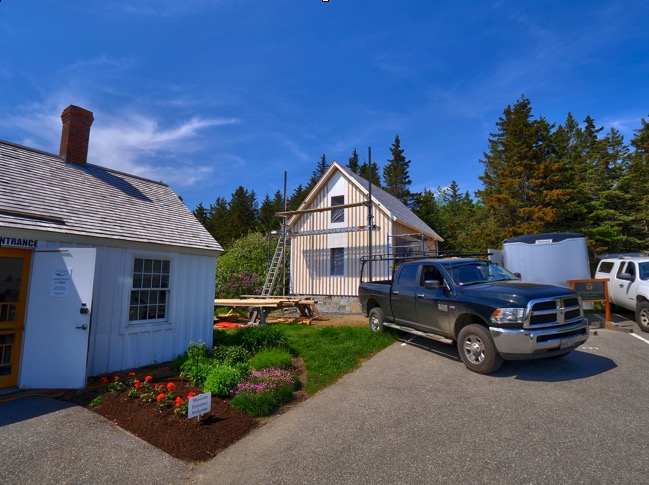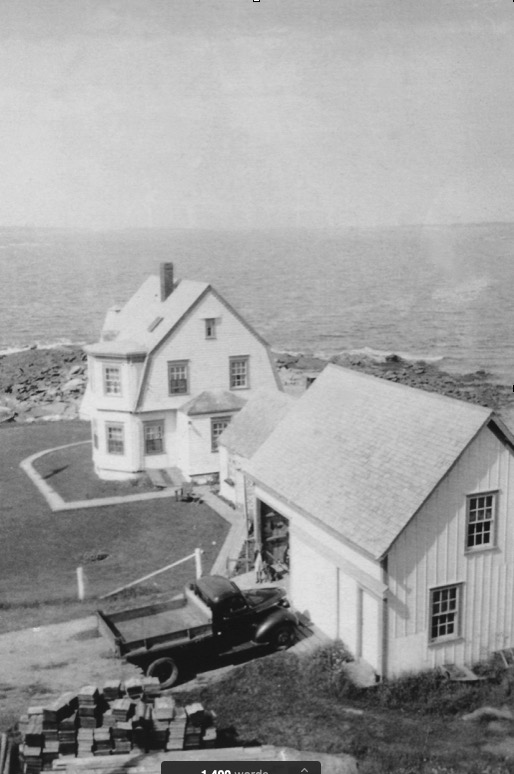The U. S. Lighthouse Service was established in 1789. The oldest lighthouse in the town of St George is on Whitehead Island in Penobscot Bay, built in 1804. There are 22 other lights in Penobscot Bay.
The Marshall Point Light Station’s history began in 1831, when Samuel Marshall sold 4 acres of land to the U.S. government for $120. Additional acres were added later to extend the site to 6.5 acres. Thousands of visitors enjoy its quarter mile of shoreline every year.
Lighthouse
The first lighthouse at Marshall Point, made of rubblestone, was built in 1832. The round tower, made of the same material, was 20 feet high, 17 feet in diameter at the base, and 9 feet at the top. The base was 3 feet thick and the top 2 feet. The base of the lantern was made of soapstone, 4 inches thick. The “light” consisted of 7 separate lard oil lamps, each with a 14 inch reflector, 4 in one row, and 3 directly above, all pointing out to sea. The tower and Keeper’s house cost $2,973.17. John Watts became the first Keeper.
In 1858 a new tower was built at its present site, at water’s edge. It is 24 feet from base to light level, the first 12 feet are constructed from granite blocks and the remaining 12 are brick. The lantern is cast iron and contains the light, which is 29½ feet above sea level. The ball on top is called a ventilator ball, made of cast iron. Above it is a lightning conductor spindle. A Fresnel lens replaced the 7 lamps, classified as a 5th order light, white and fixed (not flashing). The new tower cost $5,000.
1898 saw the addition of a bell tower with a bronze bell attached on the outside. The 36 inch diameter bell weighed 1,018 pounds. A weighted mechanism (something like a grandfathers clock) with a hammer protruding through the tower wall struck the bell. A winding lasted 4½ hours, with the hammer striking the bell every 20 seconds. The U. S. Weather Bureau constructed a weather mast displaying signal flags at that time, and a telephone service was added. In 1969 a fog horn replaced the bell and the bell tower was dismantled.
Electricity modernized the light in 1935, with a kerosene oil wick lamp for standby. By 1971 automation of the light negated the need of a light keeper. In 2018 the Coast Guard removed the Fresnel lens and replaced the automated light ( a museum piece) with a LED light encased in plastic. A battery back-up assists during power failures.
Keeper’s House
The first Keeper’s House accompanied the 1832 tower. A 1859 photo shows 3 chimneys on the roof. Specifications for the house indicate that it was 46 by 20 feet with stone walls 1½ feet thick. There were 3 rooms downstairs and 3 upstairs, with a fireplace in each downstairs room. The keeper used a crane in the kitchen fireplace and an oven for baking. Renovations to the interior took place in 1879. A picture shows 2 chimneys instead of 3, and we assume that stoves replaced the fireplaces. A summer kitchen and a barn with small outbuildings are visible in the photograph.
Lightning struck and destroyed the Keeper’s house In June. By November, 1895 a new house, the present structure, was built. Plans exist for this house, built in late 19th century Colonial Revival style with a gambrel roof. The stoves in the Keeper’s house burned coal, brought by the Lighthouse Inspection boats. Rain water filled a brick cistern in the cellar holding 1,500 gallons, supplying most of the water. It is no longer there, but the outline of the base is visible. A well, dug in the woods behind the house supplied water for a while, although it is no longer functioning.
[Left] The photograph has this description of the renovations: “The stone keeper’s house after it was renovated in 1879. (Two chimneys in place of three.) The renovations were internal, rather than external. The tiny building at right was the rivy. The larger a workshop. When the house was destroyed by lightning in 1893, the workshop was moved to a site nearer the entrance to the property and the Skinner family lived in it until the new house was built.”
Lightkeepers
Charles Skinner, Lightkeeper 1874 - 1919
The Lightkeeper who served the station for the longest period was Charles Clement Skinner, a Civil War veteran who worked at Marshall Point from 1874 to 1919 (the longest tenure of a keeper at the same light in the history of the Lighthouse Service). He had a wife and 6 children, one son and five daughters. The two youngest daughters were both long-lived. Eula Kelley was born in the old Keepers house in 1891 and lived until 1993, her last years in a cottage that her father built on Marshall Point Road. Marion Dalrymple was the first child born in the present Keeper’s house in 1895. She lived with her sister until her death in 1992. Both sisters attended the opening of the restored Keeper’s house in 1990.
Charles Allen, Lightkeeper 1933 – 1946
The Coast Guard took over the Lighthouse Service in 1939. Charles Allen’s service as a keeper spanned the two administrations.
The final keeper, Will Boddy, departed in 1971, with the introduction of automation to the Light. Establishment of a LORAN Station at Marshall Point necessitated renovations to the interior of the house. However, the LORAN equipment became obsolete, and in 1980 the Coast Guard boarded up the Keeper’s House.
The Town of St. George took a 3 and later a 5 year lease on the grounds to keep the site available to the public.
Restoration and Current History
In 1986 the St. George Historical Society took the responsibility of restoring the House, under the Town’s auspices. A Committee was established to raise money and oversee the restoration, which began in 1988. The Town signed a 30 year lease with the Coast Guard for the house and the grounds. The Light, connecting ramp, and oil house remained under Coast Guard control.
In 1989 tenants moved into the apartment on the second floor. The Marshall Point Lighthouse Museum on the first floor was opened in 1990. It is open during the summer and staffed entirely by volunteers. At least 7,500 persons visited the museum in 1991. Attendance has risen each year. In 1995, to provide more space for exhibits, and to commemorate the 100th anniversary of the Keeper’s House, a replica of the Summer Kitchen was erected, connecting to the Museum on the north.
Legislation to transfer ownership of 35 Maine lighthouses to federal or state agencies, towns, or non-profit organizations was proposed by the Island Institute, enacted by Congress, and signed by the President in 1996. The Town of St. George successfully applied for Marshall Point, and gained ownership in June 1998. The Coast Guard is now responsible only for operation of the light and fog horn, the latter being activated by vessels on demand using their VHF radio.
Any history of Marshall Point would be incomplete without mentioning that a scene from the movie Forrest Gump was filmed at the Lighthouse in 1993, and our iconic tower has appeared in many advertisements for various companies throughout the years.
Restoration Continues
Marshall Point Lighthouse and Museum Committee
In 2016 the Marshall Point Lighthouse and Museum Committee decided to expand the facility with the addition of a reproduction of the historic 18 x 25 foot Keeper’s Barn and Workshop, which was part of the lighthouse complex for over 74 years. The Coast Guard removed the original building in 1971.
As a National Landmark, the committee worked with the Maine Historic Preservation Commission to ensure the authenticity of the barn, using materials which reflect the era in which it was constructed near the end of the 19th century.
The new addition will provide proper storage of artifacts and display materials, as well as much needed administrative space. Thanks to the generous support of visitors, lighthouse lovers, local businesses and residents, we have met our goal of $150,000.
On Aug. 28, 2019 a ribbon-cutting ceremony marked the completion of the Keeper’s Barn and Workshop.
We are pleased to announce the we have secured a 10 year loan agreement with the coast Guard for the return of the Marshall Point 5th Order Fresnel lens from the Lighthouse Museum in Rockland, Maine. It will be displayed in spring 2020.
The Marshall Point Lighthouse & Museum depends upon donations, memberships and revenues from our shop operation to fulfill our stewardship responsibility. The Marshall Point Lighthouse & Museum operates as part of the St.George Historical Society a 501(c) 3 non-profit corporation.











